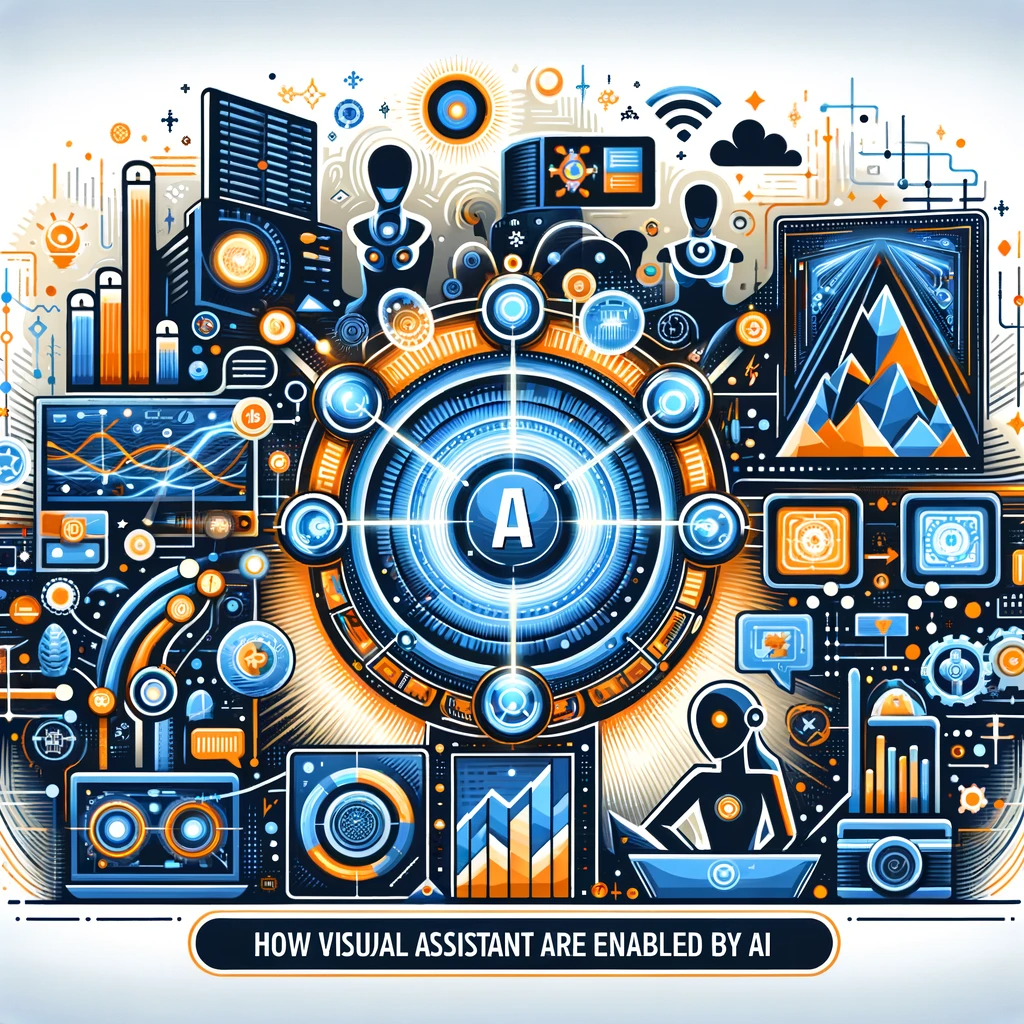How Visual assistants are enabled by AI? A query that has been occupying many people’s thoughts recently.
Technology is advancing at an unprecedented rate, and one area where this advancement is particularly noticeable is the growing use of visual assistants driven by AI.
And one area where this evolution is particularly evident? The rise of visual assistants powered by artificial intelligence.
The truth is, without AI, these interactive virtual guides simply wouldn’t exist.
Table of Contents:
- Unveiling the World of Visual Assistants
- The Intersection of Virtual and Visual Assistants
- The Rising Popularity of Voice Assistants
- Virtual Reality Meets Voice Commands
- Role of Visual Assistants in Various Industries
- Challenges and Future Prospects
- Conclusion
Unveiling the World of Visual Assistants
Welcome to a new era in technology, where artificial intelligence powers visual assistants. This revolutionary leap is changing how we interact with tech platforms across various sectors. Imagine an intelligent software system that can guide you through complex processes or help answer your queries visually. That’s exactly what AI-powered visual assistants do. A key player behind this innovation? Conversational AI technologies. Particularly, they are enabling these virtual helpers to understand and respond accurately to user inquiries.
The Impact on Customer Service, Sales & Training
No longer limited to voice commands alone, today’s smart speaker users now have access to interactive visuals for more engaging experiences. From customer service representatives solving problems in real-time using visual aids powered by conversational AI startup innovations; sales teams providing detailed product demonstrations via their AI virtual assistant – it’s clear that these advancements are transforming business operations.
Stay tuned as we dive deeper into the world of digital assistance and explore its potential impact on our daily lives. In the next section, we’ll examine how Virtual Reality intersects with Visual Assistance – a fascinating blend of technologies reshaping industries.
The Intersection of Virtual and Visual Assistants
Virtual assistants have revolutionized the way customers are served, goods are sold and instruction is given. But what happens when we add visuals to this mix?
Differences Between Virtual And Visual Assistants
A virtual assistant, like Amazon’s Alexa or Google Assistant, is an AI-powered tool that understands voice commands. In contrast, visual assistants take it up a notch by incorporating interactive visuals into their responses.
The Power of Conversational AI Technologies in Visual Assistance
Technologies such as natural language processing (NLP), enable these intelligent software systems to comprehend user queries accurately. They then respond with relevant information displayed visually for better understanding.
This combination provides users with a more engaging experience than traditional text-based interactions. Imagine asking your virtual assistant about the weather forecast and instead of just hearing it; you see it on screen. The use cases are limitless – from providing step-by-step cooking instructions through images or videos to giving product demonstrations in e-commerce platforms.
Visual assistance powered by conversational ai tech can indeed revolutionize how we interact with technology.
The Rising Popularity of Voice Assistants
Artificial intelligence has revolutionized our interaction with technology, particularly through voice assistants.
These intelligent software systems such as Apple’s Siri, Google Assistant, and Amazon’s Alexa are gaining popularity at an astonishing rate.
A Surge in Monthly Voice Assistant Users
Voice assistant market share consumers:
- In 2023 alone, the number of adult voice assistant users is projected to reach a staggering figure – over 123.5 million US adults will use these tools at least once per month according to leading tech research by Insider Intelligence.
- This represents a significant portion of the population turning towards AI virtual assistance for their daily needs.
Growth Drivers: Top Voice Assistant Activities
- Browsing products online,
- Making shopping lists or setting reminders,
- Tuning into favorite music playlists or podcasts among others have emerged as top activities conducted using voice assistants based on user surveys. It is evident that businesses must adapt swiftly if they wish to remain pertinent and meet their clients’ evolving inclinations. It’s clear that companies who provide voice shopping tools can tap into this growing segment more efficiently than ever before.
We’re just scratching the surface here.
To truly understand how far we’ve come (and where we’re headed), let’s dive deeper into how Virtual Reality meets Voice Commands in our next section…
Virtual Reality Meets Voice Commands
The integration of voice commands with virtual reality is taking user experiences to new heights. This combination has been successful in various fields, creating immersive and interactive environments for users.
Innovative Applications of VR and Voice Assistants
One such application includes training programs where individuals can learn by doing, rather than just observing or reading.
Companies are increasingly taking advantage of this technology to give people the opportunity to gain experience without facing any potential risks that could come from real-life scenarios.
Voice Command Enhancements in Virtual Experiences
Moreover, adding voice assistants like Amazon’s Alexa or Google Assistant into these virtual spaces allows users to interact more naturally within them.
For instance, giving a command verbally instead of manually selecting options creates a seamless flow during gaming sessions.
Beyond Gaming: The Future Prospects
However, it’s not limited only to gaming; industries from education, healthcare, and retail are also exploring ways they could benefit from combining visual aids with intelligent software systems.
Role of Visual Assistants in Various Industries
The advent of visual assistants has revolutionized several sectors, including retail, healthcare, and education. These intelligent software systems are enhancing customer experiences and streamlining operations.
Visual Assistants as Virtual Receptionists
In the business world, visual assistants, powered by artificial intelligence (AI), are playing a pivotal role as virtual receptionists. This conversational AI tech offers seamless round-the-clock service to customers worldwide.
Sales Agent Turned Visual Assistant
Beyond being mere receptionists, these voice assistant users also act as sales agents for businesses. Retailers now leverage this technology to provide interactive product demonstrations that captivate potential buyers’ attention and improve conversion rates significantly.
In the next section “Challenges and Future Prospects,” we will explore some hurdles faced while implementing visual assistant technology along with its future prospects considering recent advancements in AI industry figures.
Challenges and Future Prospects
The journey towards integrating visual assistants in various industries is not without hurdles. One significant concern revolves around privacy, especially for voice assistant users who fear their conversations may be recorded or misused by tech companies. Recent reports on Wired, highlight this issue extensively.
Potential Bias in AI Models
Bias within artificial intelligence models also poses a challenge to the adoption of conversational AI technologies. Explains how bias can impact the effectiveness and fairness of these intelligent software systems.
Facing Challenges Head-On: The Role of Conversational AI Startups
In response to these challenges, many startups are developing advanced conversational ai tools designed with enhanced security measures and unbiased algorithms.
A Look into the Future: Visual Assistants’ Potential Growth
Despite current obstacles, recent advancements suggest promising prospects. TechCrunch’s articles on artificial intelligence, provide insights into emerging trends that could shape future developments. From virtual reality integration to providing voice shopping tools, there’s potential for growth across sectors.
AI’s industry figures show an increase in monthly voice assistant users,. This trend suggests consumers find value in using such devices regularly. With ongoing innovation from leading players like Apple’s Siri, Amazon’s Alexa, and Google Assistant; we anticipate more breakthroughs that will continue shaping our interaction with technology.
Conclusion
In conclusion, the rise of AI-powered visual assistants marks a significant milestone in the evolution of human-technology interaction. These intelligent systems, equipped with conversational AI, natural language processing, and advanced visual capabilities, are transforming our daily lives. From enhancing customer service experiences to revolutionizing sales and training methods, visual assistants are proving to be invaluable assets across various industries.
As technology continues to advance, we can expect these assistants to become even more sophisticated, offering more personalized and immersive experiences. While challenges such as privacy concerns and potential biases in AI models exist, the tech community’s ongoing efforts to address these issues are encouraging. The future of visual assistants is not only promising but also indicative of the limitless possibilities AI brings to our world.
Frequently Asked Questions (FAQs)
Q1: What distinguishes a visual assistant from a traditional virtual assistant? A1: Unlike traditional virtual assistants that rely solely on voice commands, visual assistants incorporate interactive visuals, making interactions more engaging and informative. This visual component allows for a richer user experience.
Q2: How are visual assistants impacting customer service? A2: Visual assistants are revolutionizing customer service by providing real-time, interactive visual aids. This enhances problem-solving capabilities and enables more effective communication between businesses and customers.
Q3: What role does AI play in the functionality of visual assistants? A3: AI is the cornerstone of visual assistants. It powers their ability to understand and respond to user queries, process visual data, and provide relevant visual responses, thereby making these assistants more intuitive and helpful.
Q4: What are some emerging trends in the use of visual assistants? A4: Key trends include the integration of visual assistants with virtual reality for immersive experiences, their increasing use in educational and training programs, and the expansion into retail for interactive product demonstrations.
Q5: What are the main challenges facing the development of visual assistants? A5: The primary challenges include addressing privacy concerns, mitigating biases in AI algorithms, and ensuring these technologies are accessible and user-friendly for a wide range of users.
Q6: Can visual assistants function without AI? A6: No, AI is essential for the operation of visual assistants. It enables them to process and interpret visual data, understand user requests, and provide accurate and contextually relevant responses.
By understanding and leveraging the capabilities of visual assistants, we can unlock a new realm of possibilities in human-computer interaction, making our interactions with technology more natural, efficient, and enjoyable.





